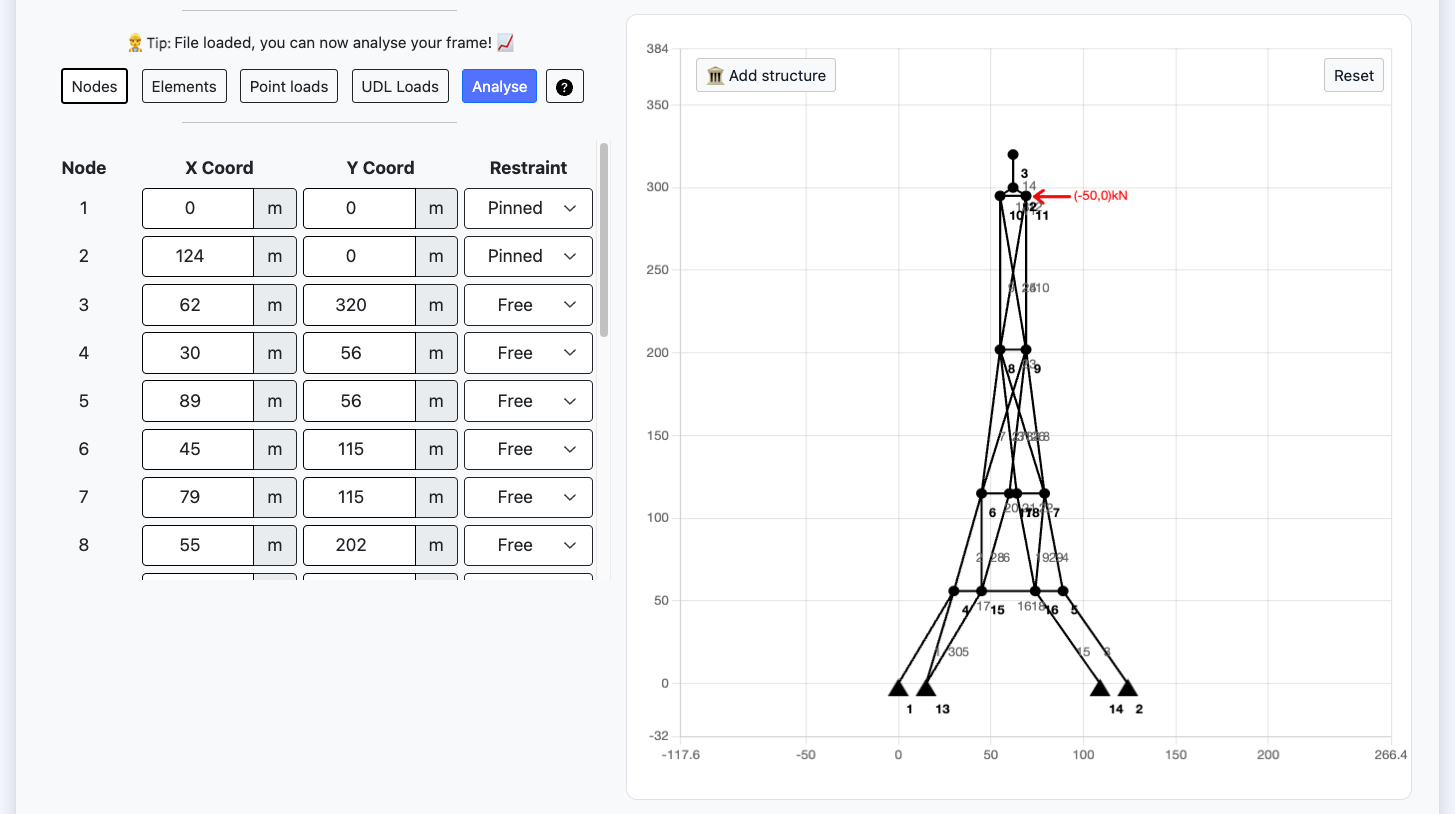Mining Design Calculator
Automatically generate a concept SCL mined tunnel design using the RMR 89, RMR 14 and Q method for rock mining.
Input mined tunnel geometry
This tool is intended for an estimate and cannot replace any design.
Excavation span
m
Enter a number between 0 & 25.
Rock UCS
MPa
Enter a number between 0 and 400.
Joint spacing
mm
Enter a number between 0 and 2,000.
Joint conditions:
Water ingress:
Joint orientation:
Results summary
Loading...
| Rock class | - |
| Rock mass rating | - |
| RQD | -% |
| Unsupported stand-up time: | - |
| Min. SCL thickness | - |
| Min Rock bolt length | - |
| Rock bolt spacing | - |
| Construction sequence | - |
| ESR value | |
| Rock class | test |
| Q rating | test |
| RQD | -% |
| Tunnel support details | Fibre reinforced shotcrete and bolting |
| Min Rock bolt length | -m |
| Rock bolt spacing in shotcreted areas | m |
| Rock bolt spacing in unshotcreted areas | -m |
Loading...
RMR 89 Calculation
The RMR rating is calculated by summing the rating from the following five parameters. These parameters are calculated used the empirical charts shown below, presented by Bieniawski in 1973.
| Category | RMR Score |
|---|---|
| UCS of intact rock | - |
| Discontinuity spacing | - |
| RQD | - |
| Discontinuity condition | - |
| Water ingress | - |
| Joint orientation | - |
| - |
RMR 89 to RMR 14 Correlation
RMR 14 can be correlated to RMR 89 using the method presented in the book 'Ground Characterization and structural analyses for tunnel design' by Celada et al (2020). Whereby mapping of 2,298 tunnel faces was used to correlate the two ratings.
RMR 89:
RMR14:
RMR 14 to Q Method Correlation
To correlate RMR 14 and the Q method rating, 101 representative cases were assessed and presented in the book 'Ground Characterization and structural analyses for tunnel design' by Celada et al (2020).
RMR 14 rating:
Q Method rating:
Rock UCS chart
UCS: MPa
UCS RMR score:
Joint spacing chart
Avg. joint spacing: mm
Joint spacing RMR score:
Discontinuity & RQD correlation
Avg. joint spacing: mm
RQD: %
RQD Chart
RQD: %
RQD RMR score:
Discontinuity condition
| Condition of discontinuity | RMR |
|---|---|
| Very rough surfaces, no separation, unweathered walls | 30 |
| Slightly rough surfaces, separation <1mm, slightly weathered walls | 25 |
| Slightly rough surfaces, separation >1mm, highly weathered walls | 20 |
| Slicken sided sufaces, seperation 1-5mm continuous | 10 |
| Seperation >5mm continuous | 0 |
Water ingress
| Ground water condition | RMR |
|---|---|
| Completely dry, no inflow per 10m tunnel length | 15 |
| Damp, <10litres/min per 10m tunnel length | 10 |
| Wet, 10-25litres/min per 10m tunnel length | 7 |
| Dripping, 25-125litres/min per 10m tunnel length | 4 |
| Flowing, >125litres/min per 10m tunnel length | 0 |
Joint Orientation
| Joint orientation adjustment | RMR |
|---|---|
| Strike perpendicular to tunnel axis. Excavation with dip (45-90°) | 0 |
| Strike perpendicular to tunnel axis. Excavation with dip (20-45°) | -2 |
| Strike perpendicular to tunnel axis. Excavation against dip (45-90°) | -5 |
| Strike perpendicular to tunnel axis. Excavation against dip (20-45°) | -10 |
| Strike parallel to tunnel axis. Excavation against dip (45-90°) | -12 |
| Strike parallel to tunnel axis. Excavation against dip (20-45°) | -5 |
| Dip of 0-20° in any direction | -5 |
What's this calculator used for?
This tool can be used by Tunnel Engineers and Geotechnical Engineers estimate the stand up time of a cavern or mined tunnel in rock conditions, but the rock mass rating or Q method.
Interested in learning more about automation?

Enroll on our training certifications and learn how to code, build AI applications with no-code tools and automate tasks.
Further information on this calculator
How are mined tunnels constructed?
- Tunnels can only be mined in certain ground conditions. To construct a mined tunnel the ground through which you are tunnelling has to be stable and self supporting until such a time that the lining or supports for the tunnel can be installed. As a result of this mined tunnels are often constructed in rock or stiff clays. Without extensive ground improvement constructing a tunnel in permeable ground below the water table is near impossible and tunnel collapse is highly likely. Often mined tunnels are constructed in smaller stages to create the full profile needed. The overall span of a mined tunnel is directly linked to stand-up time, with the larger the span of the tunnel meaning the less stand-up time expected.
How to calculate mined tunnel stand up time?
- The stand up time of mined tunnels can be estimated used the RMR 89, RMR 14 or Q System.
How to calculate the RMR 89 score?
- The Rock Mass Rating (or RMR) is a classification method for rock. The RMR method uses the compressive strength of the rock, drill core quality (RQD), spacing of discontinuities, condition of discontinuities and groundwater inflow to calculate an overall RMR rating.
How to calculate the RMR 14 score?
- The RMR 14 classification system was developed to provide an enhanced and more accurate classification system over the more traditional RMR 89 system.
How to calculate the Q system for rock?
- The Q System is a classification system for rock masses regarding the stability of underground openings. Tunnel or mine support systems can be recommended from the calculated Q System score. Six properties of the rock mass are used to estimate the Q System Score with these being rock quality designation (RQD), number of joint sets, roughness of joints, degree of alteration of joints, water inflow, stress condition.
- Rock opening supports can be estimated using schematic support chart related to the Q system score. This means that by calculating the Q value it is possible to find the type of support which has been used on past projects with a similar rock classification.


